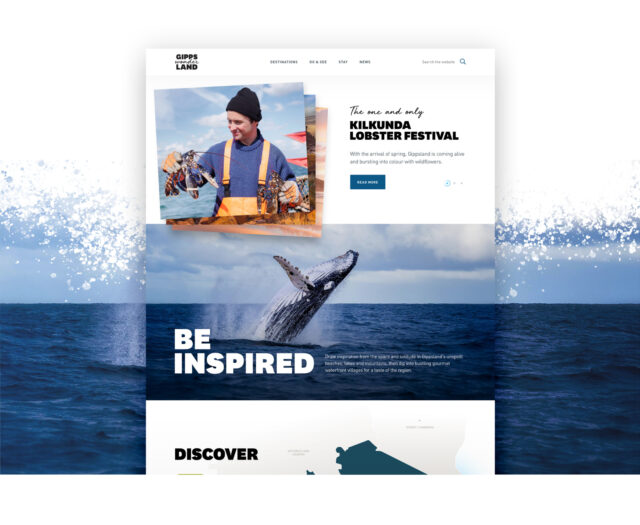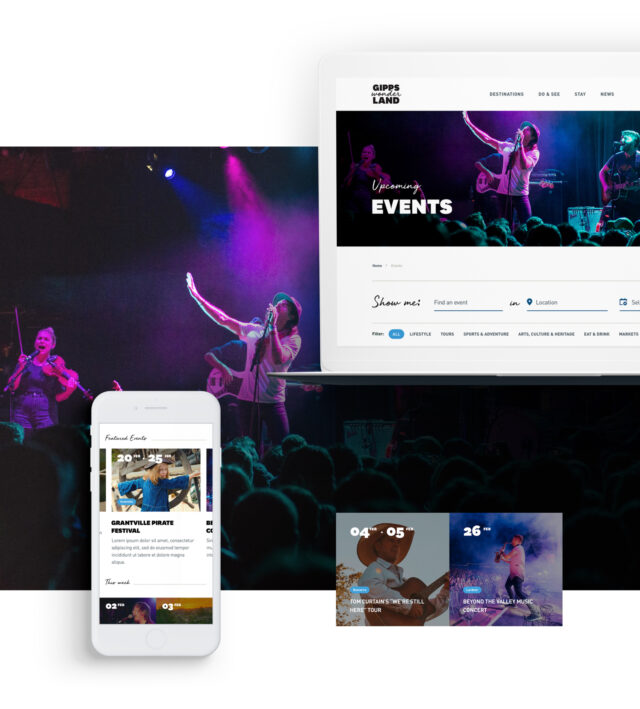
Destination Gippsland
A digital adventure for Gippsland
The Gippsland region is undoubtedly a hidden gem of the domestic tourism industry. From quaint rural towns to stunning deserted beaches and snow-capped mountains, the region has a huge amount of relatively untapped tourism potential.
Given the area’s huge potential, the Gippsland tourism industry was experiencing exponential growth and their website couldn’t keep up with the demand. Traffic wasn’t the only problem; the user experience wasn’t particularly pleasant either. They had a number of web properties that were not meeting the needs of an organisation from an operational, commercial and user-experience perspective, so Destination Gippsland headed up a project to bring these all together.
One of the primary objectives of the redevelopment was to combine existing Gippsland web properties into one overarching platform that would meet the needs of all stakeholders including consumers, industry partners and event managers.
The new Destination Gippsland website features custom pages to build itineraries, a redesign resources section for travel agents, interactive maps for engaging user experience, social feeds and sharing, an upgraded search function and SEO optimisation for high search visibility.

Destination Gippsland desired a user-centred approach that focused heavily on the needs of the user. The entire online experience had to not only revolve around user’s wants and needs, but also provide Destination Gippsland with a deep understanding of their audience and an ability to tailor content. They needed a best-in-class experience that exceeded their expectations.
We kept three main objectives at the front of our minds: awareness, engagement and conversion.
Awareness
We wanted to increase awareness of Gippsland as a tourism destination by delivering a comprehensive platform with a user-centred focus, best-in-class ‘visitability’ and trip-planning tools. This, along with a well-researched supporting digital strategy, would significantly increase Gippsland’s profile for both international and domestic tourism markets, while also increasing understanding and knowledge of the region’s key attractions.
Engagement
The new Destination Gippsland website needed to deliver a far more satisfying online experience. This could be done by providing rich, tailored content for each audience segment along with powerful tools for search and planning, as well as features designed to facilitate repeat visitation, like user accounts and favourites.
Conversion
Conversion is the key to delivering a truly successful project outcome and we needed an overarching digital strategy targeted at the right audiences. By unifying the region’s attractions into a single comprehensive platform, along with improved tools to make discoveries and bookings, we believed that the website would ultimately increase conversions and bookings with the region’s many operators

A platform built for scale
We identified that Destination Gippsland would need a platform that allowed data integrations to make management and maintenance of site content easier. They also required a redesigned, re-branded experience that would revitalise the Gippsland tourism industry online.
Destination Gippsland had found it extremely difficult to maintain the original website given the growth in business as well as the need to raise awareness and engagement. The previous website was not designed with growth, scalability or flexibility in mind. Consequently, the website’s technical performance was lacking with no security to protect users, slow page speeds and a very average SEO performance.
The website needed a superior user experience that performed well and had engaging content that would attract more visitors to the region. It was key for the website to provide content to users at every stage of the journey, from researching their destination to actually being away on a holiday. This meant a focus on Gippsland’s striking scenery, as well as resources and content relating to events, local activities and accommodation providers, helping users plan the trip of their dreams.

Superior search and user experience
The original Gippsland tourism website had a poor user experience. Navigation, structure and the overall flow was confusing, particularly when browsing on mobile. The user’s inability to navigate on mobile was particularly concerning, especially if we were to provide a satisfying experience at every stage of the journey.
It’s worth noting that Gippsland is a huge area that presents specific challenges when planning a trip. The region is poorly understood by visitors, with statistics suggesting poor ‘brand awareness’, so navigation and clear, concise information from the outset became a critical aspect of the redevelopment.
After thoroughly researching the user experience, and reviewing the available data, we were able to maximise the website’s impact by developing information architecture and planning content. The site was split into various sections including ‘Destinations’, ‘Do & see’ and ‘Stay’, giving visitors the ability to explore the region online to plan their trip. We also integrated Algolia to ensure faster search times and no zero results, ultimately keeping users engaged.
In conjunction with the designer, our strategists held a workshop with the client to work through the finer details regarding target audiences and user groups. We wanted to hear the client’s objectives and ideas as to why people used the website. Most importantly, we had to define what a successful digital experience meant for both the client and their future users. As a result, we developed user personas, identified customer journeys and went into the project with a clear understanding of the primary audience and their needs.

Design driven by Strategy
Consultation was a key consideration in the design and development of Destination Gippsland’s new website. Our digital strategy specialist was in constant contact with both the design lead and the client, ensuring that the resulting design solution remained true to the deliverable objectives, consideration of user groups and the strategic consideration of the user’s flow and relevant calls to action.
The results of our extensive research into user groups were integrated into our thinking and considered in every phase of the build including information architecture, sitemap and navigation development. This allowed us to build a website that met the needs of every potential audience, driving users towards completing actions that aligned with organisation objectives.
Advanced Search Optimisation and Reporting and Analytics
On top of this, we implemented search engine optimisation measures when building and launching the site. More specifically, we implemented technical and on-page SEO measures to ensure the site was given every possible chance to appear in Google Search results after its launch. As previously mentioned, the poor SEO performance of the website’s previous iteration was of serious concern.
The final step was to implement advanced tracking and analysis. This started with a tracking plan to map out the detailed tracking implementation on the website, including the tracking strategy, audience segments, tagging and goal configuration. Our tracking implementation provided Destination Gippsland with the data to demonstrate how their digital initiatives impact the business’s bottom line. Being able to show the value of the project means they can justify existing and future investments.